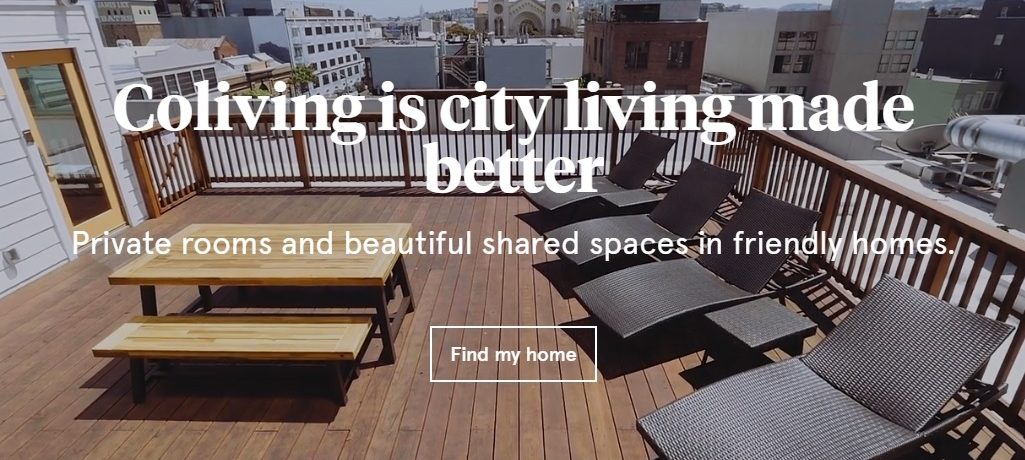The Phenomenon of Coliving
Is the growing interest and investment in common living going to solve the US housing problem? Is it a threat to traditional home ownership and rental housing leasing?
Coliving appears to be a housing market trend to note and it’s in your neighborhood already. Like Airbnb short term rental and Wework office sharing, it has its reason for existing and it’s not a fleeting trendy niche. In fact, it may be the next business opportunity for property managers and investors.
KnightFrank in their research study calls the phenomenon “renting a lifestyle” in the world of plug and play living.
How popular is coliving? Recently, NYC based co-living operator Common teamed up with a Los Angeles developer to create a new development in Los Angeles. There were 9000 applications for spaces in 24 units. The founder of the company stated that “We see huge demand in Los Angeles for shared furnished apartments that rent for $1,300 to $1,800 per month.” But is lower price all that tenants are looking for?
What is Co-living?
Co-living as it’s name implies is a housing arrangement of any lease period where renters share common areas of a home or apartment unit such as kitchens, living rooms, and other amenities with other tenants yet have a private bedroom.
Since most Millennial renters have shared student housing experience, this new trend to shared living spaces isn’t foreign to them. The sheer size of the Millennial generation means developers and investors (and property management companies) don’t need to cater to other demographics.
Millennials are driving coliving development just as they are with shared office spaces. Is this a threat to the mulitfamily housing sector? It’s a unique market serving unique renter needs, but perhaps in the end, it’s just another segment of the multifamily housing market.
Is Coliving the New Airbnb?
Some suggest coliving is part of the huge sharing economy. That connection might be weak though as the real goal of millennials is better lifestyle, freedom, and career growth. The demographic segment which coliving operators typically target are Millennials with incomes between $40k to $80k.
A new era called Coliving 2.0 is targeting more upscale tenants. The luxury trend is to watch for since the new accommodations might surprise those who think this is downscale living.
Millennial growth in other countries is far greater than in the US or UK. Technologies and growth generated in countries such as India and China will arive in North America, UK, Germany and Australia.
Coliving in Europe
Quarters of Berlin, a subsidiary of the Medici Living Group is building 35 new developments after a $1.1 billion fundraising round with Corestate Capital. $300 million of that is slated for the US.

Screen Capture courtesy of goquarters.com
Why the Demand for Coliving?
Wework, Welive, what’s next, WeSubway? See what a day in the life of a coliving person looks like in this HBO series video.
Common has plans to build a new $200 million development in Los Angeles. As more data regarding data and ROI come in, more investors will be interested in these types of coliving developments.
Here’s how Common approaches the new market of coliving developments
Coliving has its similarities to college dormitory lifestyle and housing model yet clearly advanced amenities and increased privacy make it different. The initial attraction might be lower rents, however a quick check of coliving rent prices shows they aren’t as low as expected.
The lower coliving rents get the attenion of graduating students and others who need affordable accommodations or who want to save for a downpayment on a home purchase.Is coliving as a multifamily housing segment going to take off? In congested urban areas such as San Francisco and New York, the coliving concept is taking off. Rents are high enough per renter to add up to substantial revenue for a building. And this is why investors are starting jump on the coliving opportunity.
Unique, Rare Living Opportunities
Visit websites such as ollie.co and right away you’ll see their unique value proposition beyond saving money. If rents aren’t super low (20% less on average than competing small apartments), then the property, leasing terms, and community have to prop up the value proposition.

Screen Capture courtesy of Knight Frank
The location of coliving developments near ski resorts, vacation destinations, major downtown business districts, and in wonderful cities shows coliving may be a window into a dreamed of lifestyle or career. Given the rent prices in Manhattan and Silicon Valley, coliving might be a window into a better life for many millennials and the leading edge of Generation Z.
Ollie has locations in Boston, Pittsburgh, Los Angeles and New York City.
There’s no limiting the imagination as developers consider coliving creativity.
What are The Benefits of CoLiving?
- better affordability in expensive cities
- shorter commutes to work
- access to downtown amenities
- better access to jobs in downtown districtions (e.g., Wall Street)
- cleaning services, laundry, free wifi, and other perks
- fully-furnished units
- more social than living alone or in hotels
What’s the Downside to Coliving?
In one report in the UK’s guardian newspaper, a reporter who is a nomad digital copywriter tells of her coliving experience in New York City. For her, coliving beats hotels by being cheaper, and she felt less lonely with others around. She met some interesting people from around the world.
However the tight spaces, NYC traffic noise and loud conversations of other tenants were not her cup of tea, but that’s NYC isn’t it? The lack of refrigerator space meant she could only store small amounts of food — inconvenience, more time shopping and higher grocery bills.
Yet the downside of co-living is likely something developers are working on. More washers and dryers, larger refridgerators, living space re-design, higher quality appliances, more sound insulation can mitigate the frustrations.
Technology Key to Success of CoLiving
Millennials drive this housing segment and they love new technology. With technology as amenity growing in importance, and on demand property management in vogue, there’s lots of interest in proptech solutions.
From keyless entry to IoT refrigerators and energy efficient lighting controls, to online tenant portals and 5G possibilities, proptech is entering its time in the limelight.
Keeping up on property management technology is tough, so please bookmark this page and pass it onto friends on Facebook who might like to know rental housing trends will affect them.
Also from our property management blog: Management Software | Rental Property Software Reviews | Real Estate Market | 8 Ways to Grow Rental Property ROI | State of Property Management | California Housing Market | San Jose Housing Market | Cloud Property Software | UK Housing Market | Housing Market Hawaii | Australia Housing Market | Multifamily Housing | Los Angeles Rent Prices | Property Management Software Germany | Rental Housing Market | Apartment Rental Prices





